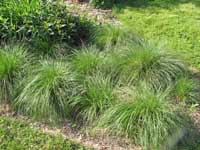 | | Consider replacing some of your turf grass with plants such as Prairie dropseed (Sporobolus heterolepis) |
Plan for less lawn this year
Chances are your lawn isn't looking so good right now. It's a good time to consider reducing its size.
Why have less lawn?
* It takes a lot of work and money to keep it looking good. After all, it wasn't meant to grow here! * It's a biological desert, providing nothing for wildlife, and using space (63,000 square miles of space) that could otherwise support life. * It creates many environmental problems: - water pollution from lawn fertilizers and herbicides, - high water use, - health risks for our children, pets, and wildlife from pesticides, - air pollution from fossil fuel-powered lawn equipment, - noise pollution. How nice it would be to enjoy our weekends without the incessant roar of lawn mowers! * Lawns are s-o-o-o boring. A multi-year project It's probably not a good idea to get rid of all of it at once--it would just be too much work, and it's hard to visualize large changes in your yard. Instead, create a three-year plan or even a five-year plan for reducing your lawn. You could replace perhaps 10% to 20% each year with plantings that would be more interesting and healthier for people, wildlife, and for the planet. Probably requiring the least work (once plants are established) are native trees and shrubs, especially if they're in one big planting bed, perhaps long the side of your yard, so you don't have to be mowing around individual specimen plants. How-to Attending our Carolyn Summers workshop on April 2 (see above) will give you lots of ideas for what you can plant instead of lawn. For additional information on how to get rid of lawn (hint: Digging it up is NOT the easiest way) and for ideas of what to plant instead: * LessLawn.com - Explore the site and you'll get lots of ideas for different designs to fit your taste as well as how to smother your lawn. * Bayscapes: Homeowner's Guide to Designing Your Property - an excellent guide that helps you visualize some ideas for your yard. Putting lawn reduction into context And for inspiration to take this step, read Michael Pollan's article "Why Mow? The Case Against Lawns" (Although--horrors!-- in his own yard, he replaced some of his lawn with forsythia, bittersweet, and lilac--all non-natives. We can do better than that!) |